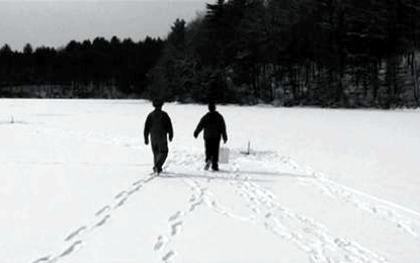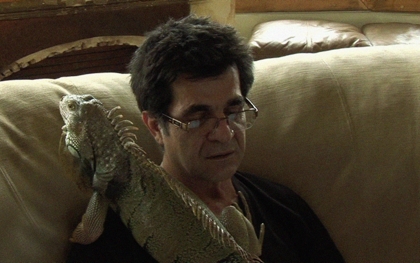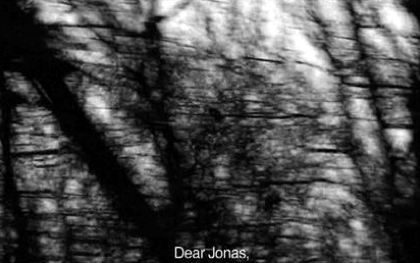Festivals
London Film Festival 2011: The S&S blog
Correspondences: Jonas Mekas,
José Luis Guerín, Jafar Panahi

Correspondence
Mar Diestro-Dópido, 21 October
The sheer number of films screened at the larger film festivals effectively means each viewer creates their own personalised festival programme based on a series of not entirely conscious decisions, which can often produce surprise collisions and chance encounters between directors and films. My own choices on day 8 of the LFF, a sunny and crisply cold afternoon at BFI Southbank, put me in the stimulating company of three world-class filmmakers – expat Lithuanian Jonas Mekas, Spaniard José Luis Guerín and Iranian Jafar Panahi – and made me witness to a wholly unexpected but fascinating dialogue between Correspondence: Jonas Mekas - JL Guerín and Panahi’s This Is Not a Film.
‘Correspondences’ is itself a dialogue project originally set up by the CCCB (Centre of Contemporary Art in Barcelona), in which a series of filmmakers are invited to exchange digital visual ‘letters’ about cinema, filmmaking and the world around them. The process was inaugurated by Víctor Erice and Abbas Kiarostami (2006), and includes an exchange between Albert Serra and Lisandro Alonso, The Lord Worked Wonders in Me, also screened at this year’s LFF.
Mekas and Guerín’s Correspondence comprises a total of four digital letters each and an epilogue by the latter, all shot between 2009 and 2011. Guerín, a long-time admirer of Mekas, whose filmmaking philosophy of simply reacting to life and being open to chance Guerín religiously applies to his own films, initiated this particular exchange when visiting Mekas in New York.

This Is Not a Film
Not dissimilarly, Panahi’s This Is Not a Film is a meditation on the powerful need to film, and on being prevented from doing so; we see him in his flat awaiting the outcome of an appeal against accusations of anti-government activities, forbidden to pick up a camera or direct until judgement is passed. As festival director Sandra Hebron pointed out in her introduction, Panahi has since been banned from filmmaking for 20 years, and imprisoned for six.
On New Year’s Eve 2010, with symbolically menacing explosions of fireworks as background, Panahi decided, with the help of his collaborator Mojtaba Mirtahmasb, to make this ‘not-film’ in his flat in Tehran, in essence a letter to the future. It consists of Panahi’s narration of one of his banned screenplays, a reflection on his own cinema and a testament of the day he was supposed to find out about the resolution of his trial – because as Mirtashmasb says, what is most important is that we “document everything”.
As Mekas explains, the need to film goes beyond “all that business of reality and poetry. What I’m doing is videotaping moments of life, details I have the need to tape for some reason I don’t know. I have tried to rationalise it, but what I do is what you see, fragments that I tape as life continues. A few moments. Explanations are only part of the game.” It is this inexplicable urge and necessity that makes Panahi risk taking a camera out of his flat to document an encounter in the lift.

Correspondence
Memory, history and ghosts figure in each of these ‘letters’ – moving testaments to cinema’s capture of lost moments, a doomed attempt to arrest life’s ephemerality. By chance I happened to be present at the film festivals in both Lisbon and Ljubljana where Guerín met and filmed Nika Bohinc, the young Slovenian film critic and programmer who was murdered with her Filipino film-critic partner Alexis Tioseco in September 2009 at their house in Manila. Guerín’s third letter is a moving homage to Nika, which not only recalls in its form the painterly study of female faces in his acclaimed In the City of Sylvia (2007), but also gives life to a ghost through editing and repetition, recalling the female presence in the footage he rescues and re-edits in his 1997 film Train of Shadows.
This activity is replicated by Mekas, who we see at his editing table summoning and reflecting on the ghosts of his own past, faded figures in the outtakes of his films that he has decided to collect and edit together in what will be his last testament, which he’ll simply call Footage. The most distressing moment in This Is Not a Film sees Panahi reading his script aloud and attempting to show us a film he cannot make – effectively a ghost film. He carefully divides the rug in his living room with Sellotape to recreate the set and invokes the spirit of his female protagonist (herself imprisoned in her own home), until his escalating desperation culminates in him breaking down.
For all their underlying melancholy, each of these works is united by a playful sense of humour and a liking for animals – pigeons, an iguana, a cat, and a group of stoic ants at Ozu’s gravestone in Japan. Aesthetically they couldn’t be more different, though they’re united by that common Mekas notion of ‘reacting to life’. The restrictions placed on Panahi inevitably impose a domestic naturalism, far removed from Mekas’s distinctive hand-held fragments and Guerín’s crisply beautiful black-and-white images, described by Mekas as “a pure and clear style”. (In the Q&A after Correspondence, Mekas’s first words were: “I take my hat off to Guerín’s mastery.”)

Correspondence
It’s Guerín’s gaze that most clearly structures Correspondence. And yet it is precisely in the contrast between his rigour and Mekas’s highly (to use his own words) “personal and confused”, colourful and chaotic “taping of fragments of life” that meaning – and maybe that hidden order which Guerín is always seeking to capture with his camera – is created and revealed. At the end of the day, filmmakers react as much to each other’s works as they do to life, and the potent (albeit momentary) connections produced by the CCCB series act as a corrective to what Guerín believes is “a time in which filmmakers are more isolated” from one another than ever before.
Most importantly, film allows these three directors to establish a dialogue with the past, history and their own and each other’s present. Tellingly, Mekas captures his own shadow cast on the wall of an 18th-century prison he visits in Poland, while Guerín’s own musings on isolation, rootlessness and displacement – the core of his latest film, Guest – all resonate with Panahi’s situation. But ultimately what unites these three is their need to carry on filming in order to make sense of their world, and the transformative, transgressive force that their films acquire from their ceaseless curiosity, their inspiring faith in the power of cinema. After all, in the words of Mekas, “Reality won’t save us, but dreams will.”
« Chicken with Plums: over-plummed?
Rich and strange: The First Born »
See also
More on This Is Not a Film: Gabe Klinger on the video’s Cannes premiere (May 2011)
The green badge of courage: Gabe Klinger talks to filmmaker Rafi Pitts about the imprisonment of Jafar Panahi and Mohammad Rasoulof and his open letter to Iran’s President Ahmadinejad Badlands (March 2011)
Offside reviewed by Julian Graffy (June 2006)
Crimson Gold reviewed by Julian Graffy (November 2003)
The Circle reviewed by Julian Graffy (October 2001)
